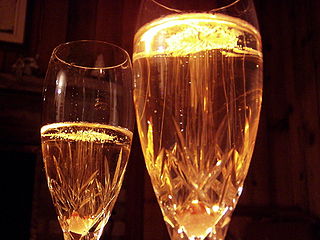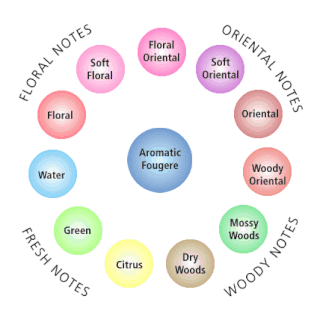Related Research Articles
Oenology is the science and study of wine and winemaking. Oenology is distinct from viticulture, which is the science of the growing, cultivation, and harvesting of grapes. The English word oenology derives from the Greek word oinos "wine" and the suffix –logia the "study of". An oenologist is an expert in the science of wine and of the arts and techniques for making wine.
Carole P. Meredith is an American grape geneticist and was a professor at the Department of Viticulture and Enology of University of California, Davis.
A wine fault or defect is an unpleasant characteristic of a wine often resulting from poor winemaking practices or storage conditions, and leading to wine spoilage. Many of the compounds that cause wine faults are already naturally present in wine but at insufficient concentrations to be of issue. In fact, depending on perception, these concentrations may impart positive characters to the wine. However, when the concentration of these compounds greatly exceeds the sensory threshold, they replace or obscure the flavors and aromas that the wine should be expressing. Ultimately the quality of the wine is reduced, making it less appealing and sometimes undrinkable.

The following outline is provided as an overview of and topical guide to wine
The American Society for Enology and Viticulture, founded in 1950, is a non-profit, scientific wine production industry organization headquartered in Davis, California.
The Department of Viticulture and Enology at the University of California, Davis, located in Davis, California, offers undergraduate and graduate degrees in the areas of grape growing and wine making. Located just 45 minutes from Napa Wine Country the department has strong connections with wine producers in California and elsewhere. The department has produced many of the notable winemakers of the California wine industry.
Coffee cupping, or coffee tasting, is the practice of observing the tastes and aromas of brewed coffee. It is a professional practice but can be done informally by anyone or by professionals known as "Q Graders". A standard coffee cupping procedure involves deeply sniffing the coffee, then slurping the coffee from a spoon so it is aerated and spread across the tongue. The coffee taster attempts to measure aspects of the coffee's taste, specifically the body, sweetness, acidity, flavour, and aftertaste. Since coffee beans embody telltale flavours from the region where they were grown, cuppers may attempt to identify the coffee's origin.

The use of wine tasting descriptors allows the taster to qualitatively relate the aromas and flavors that the taster experiences and can be used in assessing the overall quality of wine. Wine writers differentiate wine tasters from casual enthusiasts; tasters attempt to give an objective description of the wine's taste, casual enthusiasts appreciate wine but pause their examination sooner than tasters. The primary source of a person's ability to taste wine is derived from their olfactory senses. A taster's own personal experiences play a significant role in conceptualizing what they are tasting and attaching a description to that perception. The individual nature of tasting means that descriptors may be perceived differently among various tasters.

The phenolic content in wine refers to the phenolic compounds—natural phenol and polyphenols—in wine, which include a large group of several hundred chemical compounds that affect the taste, color and mouthfeel of wine. These compounds include phenolic acids, stilbenoids, flavonols, dihydroflavonols, anthocyanins, flavanol monomers (catechins) and flavanol polymers (proanthocyanidins). This large group of natural phenols can be broadly separated into two categories, flavonoids and non-flavonoids. Flavonoids include the anthocyanins and tannins which contribute to the color and mouthfeel of the wine. The non-flavonoids include the stilbenoids such as resveratrol and phenolic acids such as benzoic, caffeic and cinnamic acids.

Wine tasting is the sensory examination and evaluation of wine. While the practice of wine tasting is as ancient as its production, a more formalized methodology has slowly become established from the 14th century onward. Modern, professional wine tasters use a constantly evolving specialized terminology which is used to describe the range of perceived flavors, aromas and general characteristics of a wine. More informal, recreational tasting may use similar terminology, usually involving a much less analytical process for a more general, personal appreciation.

The aging of wine is potentially able to improve the quality of wine. This distinguishes wine from most other consumable goods. While wine is perishable and capable of deteriorating, complex chemical reactions involving a wine's sugars, acids and phenolic compounds can alter the aroma, color, mouthfeel and taste of the wine in a way that may be more pleasing to the taster. The ability of a wine to age is influenced by many factors including grape variety, vintage, viticultural practices, wine region and winemaking style. The condition that the wine is kept in after bottling can also influence how well a wine ages and may require significant time and financial investment. The quality of an aged wine varies significantly bottle-by-bottle, depending on the conditions under which it was stored, and the condition of the bottle and cork, and thus it is said that rather than good old vintages, there are good old bottles. There is a significant mystique around the aging of wine, as its chemistry was not understood for a long time, and old wines are often sold for extraordinary prices. However, the vast majority of wine is not aged, and even wine that is aged is rarely aged for long; it is estimated that 90% of wine is meant to be consumed within a year of production, and 99% of wine within 5 years.

The aromas of wine are more diverse than its flavours. The human tongue is limited to the primary tastes perceived by taste receptors on the tongue – sourness, bitterness, saltiness, sweetness and savouriness. The wide array of fruit, earthy, leathery, floral, herbal, mineral, and woodsy flavour present in wine are derived from aroma notes sensed by the olfactory bulb. In wine tasting, wine is sometimes smelled before taking a sip in order to identify some components of the wine that may be present. Different terms are used to describe what is being smelled. The most basic term is aroma which generally refers to a "pleasant" smell as opposed to odour which refers to an unpleasant smell or possible wine fault. The term aroma may be further distinguished from bouquet which generally refers to the smells that arise from the chemical reactions of fermentation and aging of the wine.

Autolysis in winemaking relates to the complex chemical reactions that take place when a wine spends time in contact with the lees, or dead yeast cells, after fermentation. While for some wines - and all beers - autolysis is undesirable, it is a vital component in shaping the flavors and mouth feel associated with premium Champagne production. The practice of leaving a wine to age on its lees has a long history in winemaking dating back to Roman winemaking. The chemical process and details of autolysis were not originally understood scientifically, but the positive effects such as a creamy mouthfeel, breadlike and floral aromas, and reduced astringency were noticed early in the history of wine.

Wine is a complex mixture of chemical compounds in a hydro-alcoholic solution with a pH around 4. The chemistry of wine and its resultant quality depend on achieving a balance between three aspects of the berries used to make the wine: their sugar content, acidity and the presence of secondary compounds. Vines store sugar in grapes through photosynthesis, and acids break down as grapes ripen. Secondary compounds are also stored in the course of the season. Anthocyanins give grapes a red color and protection against ultraviolet light. Tannins add bitterness and astringency which acts to defend vines against pests and grazing animals.

A fragrance wheel, also known as aroma wheel, fragrance circle, perfume wheel or smell wheel, is a circular diagram showing the inferred relationships among olfactory groups based upon similarities and differences in their odor. The groups bordering one another are implied to share common olfactory characteristics. Fragrance wheel is frequently used as a classification tool in oenology and perfumery.
Maynard Andrew Amerine (1911–1998) was a pioneering researcher in the cultivation, fermentation, and sensory evaluation of wine. His academic work at the University of California at Davis is recognized internationally. His 16 books and some 400 articles contributed significantly to the development of the modern (post-Prohibition) wine industry in California; to the improvement of wine cultures in Europe, South America, and Australia; and to the professional standards for judging and tasting wine.
Proteins are present in wine. The most common proteins include thaumatin-like proteins and chitinases and have a role in the formation of turbidity (haze) especially visible in white wine. The quantity of haze forming is dependent on the quantity of phenolics in the wine.
Carol Shelton is an American winemaker and entrepreneur. She has been called the most awarded winemaker in America and was the San Francisco Chronicle's Winemaker of the Year in 2005.

Yeast assimilable nitrogen or YAN is the combination of free amino nitrogen (FAN), ammonia (NH3) and ammonium (NH4+) that is available for a yeast, e.g. the wine yeast Saccharomyces cerevisiae, to use during fermentation. Outside of the fermentable sugars glucose and fructose, nitrogen is the most important nutrient needed to carry out a successful fermentation that doesn't end prior to the intended point of dryness or sees the development of off-odors and related wine faults. To this extent winemakers will often supplement the available YAN resources with nitrogen additives such as diammonium phosphate (DAP).
Albert Julius Winkler was an American professor of viticulture and one of its leading authorities. His name is famous for the Winkler index, developed with Maynard Amerine.
References
- 1 2 3 J. Robinson (ed) "The Oxford Companion to Wine" Third Edition pg 35-36 Oxford University Press 2006 ISBN 978-0-19-860990-2
- 1 2 3 L. Alley "Wine Sensory Scientist Ann Noble Retires From UC Davis" Wine Spectator, August 21st, 2002.
- 1 2 3 4 San Francisco Chronicle "Ann Noble bio" Wine Judge: Accessed Dec. 16th, 2007 Archived 4 December 2010 at the Wayback Machine
- ↑ "Congressional Record". www.congress.gov. Retrieved 2016-04-05.
- ↑ WiningWays (2011-05-16). "Wine Aroma Wheel". WiningWays. Retrieved 2016-04-05.
- ↑ "Deutscheweine.de: Das Wein-Aromarad". Archived from the original on 4 March 2008. Retrieved 30 December 2007.
- ↑ Owen Bird, Rheingold - The German Wine Renaissance, Arima Publishing 2005, pp. 90-97 ISBN 978-1-84549-079-9
- ↑ "Ann C. Noble | Viticulture & Enology". wineserver.ucdavis.edu. Archived from the original on 2016-05-05. Retrieved 2016-04-05.
- ↑ "Top 50 most powerful women in wine: 50 – 41". www.thedrinksbusiness.com. 5 December 2012. Retrieved 2016-04-05.